深圳版小学英语一年级上册全册教案
- 格式:doc
- 大小:60.13 KB
- 文档页数:78
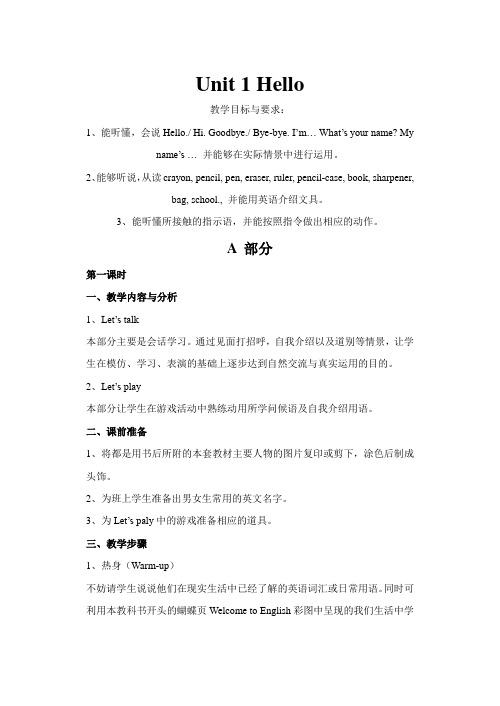
Unit 1 Hello教学目标与要求:1、能听懂,会说Hello./ Hi. Goodbye./ Bye-bye. I’m… What’s your name? Myname’s … 并能够在实际情景中进行运用。
2、能够听说,从读crayon, pencil, pen, eraser, ruler, pencil-case, book, sharpener,bag, school., 并能用英语介绍文具。
3、能听懂所接触的指示语,并能按照指令做出相应的动作。
A 部分第一课时一、教学内容与分析1、Let’s talk本部分主要是会话学习。
通过见面打招呼,自我介绍以及道别等情景,让学生在模仿、学习、表演的基础上逐步达到自然交流与真实运用的目的。
2、Let’s play本部分让学生在游戏活动中熟练动用所学问候语及自我介绍用语。
二、课前准备1、将都是用书后所附的本套教材主要人物的图片复印或剪下,涂色后制成头饰。
2、为班上学生准备出男女生常用的英文名字。
3、为Let’s paly中的游戏准备相应的道具。
三、教学步骤1、热身(Warm-up)不妨请学生说说他们在现实生活中已经了解的英语词汇或日常用语。
同时可利用本教科书开头的蝴蝶页Welcome to English彩图中呈现的我们生活中学生已经会说或较熟知的词汇如TV,CD,VCD,DVD,OK!Hi! Yeah! Bye! Cool! Wow! E-mail, cartoon等等来激发学生想学英语的兴趣和愿望。
2、新课展示(Presentation)教师播放本课的歌曲“Hello”的录音,自然引出师生之间的打招呼。
T: Hello, boys and girls.Ss: Hello, Miss? Mr….(1)、通过教师的自我介绍自然引出Hello, I’m… /HI, I’m…(2)、教师可戴上Sarah的头饰介绍Hello! I’m Sarah. 并用同样方式介绍其他人物。
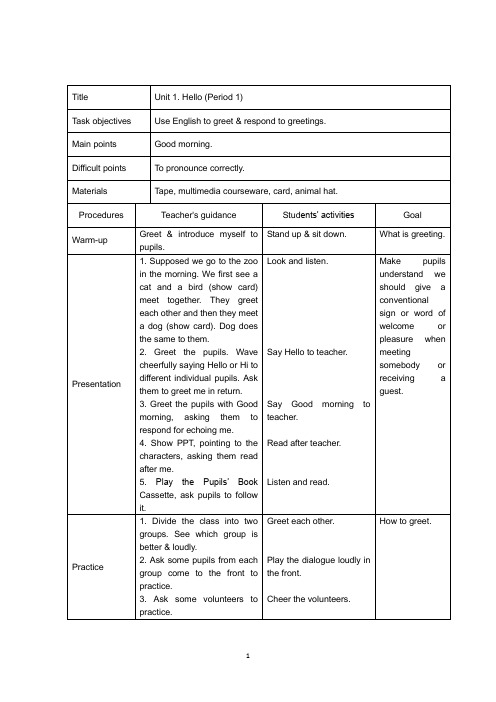
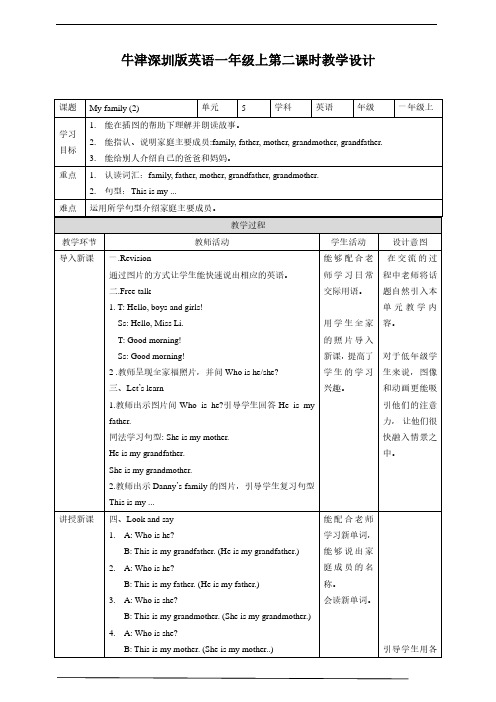
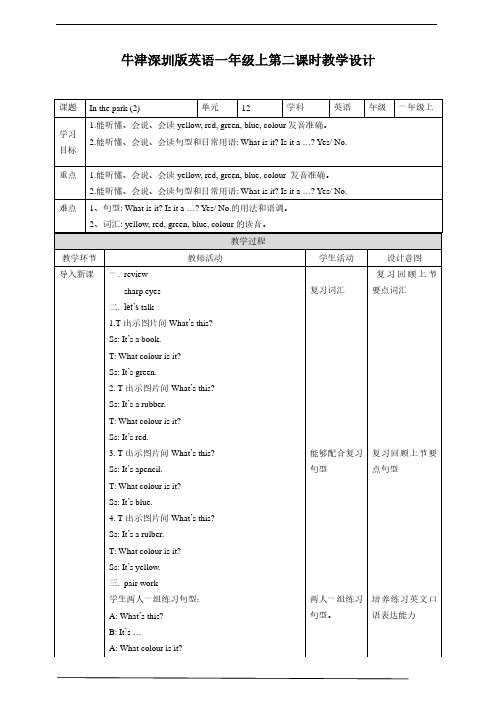
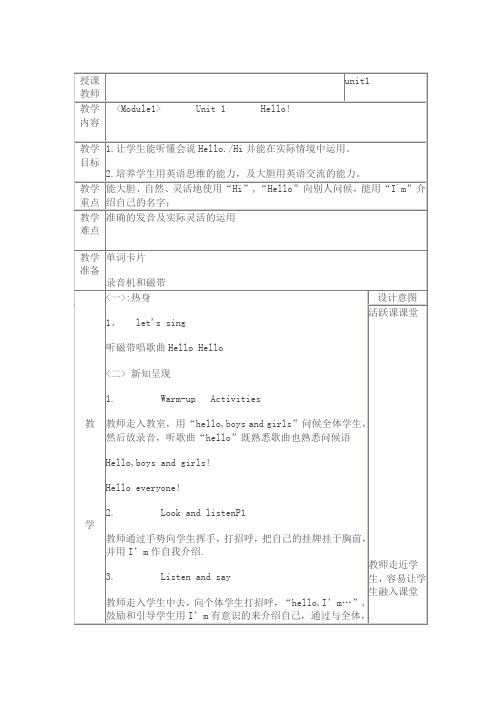
一教学重点:询问对方的姓名及回答的用语What’s your name? My name is…的学习.二教学难点:What’s your name? My name is…中name 的发音。
三教具准备:1 教师应准备自己的名字卡及本课主要人物的头饰;2 要求学生准备一个面具,并制作一个写有本人姓名的头饰。
四教学过程:1 热身、复习(Warm-up/Revision)(1) 唱“Hello”歌(2) 师生互相问候Hello! /Hi!(3) 学生将胸卡戴在胸前,分别起立做自我介绍。
如:a. Hello, I’m Mary.b. Hi! I’m Peter.(设计意图:提高学生兴趣,有利于学生口语的发展)2 呈现新课(Presentation)(1) 老师指着自己的英文名卡说Hello! I’m Miss/Mr…. 然后用My name’s…. 反复说三到四遍自己的名字,速度由慢到正常。
接着教师对一名学生发问What’s your name? (用清晰、缓慢的语调问两遍)边问边指他/她的名卡,并可以用夸张的口型提示他/她回答My name’s….教师对第一个应答学生应重点表扬,并发给他/他小奖品,以次鼓励学生认真听别人的问答,努力模仿教师说的新句型。
用类似的方法在教室里与学生进行问答练习,注意引导学生用My name’s….回答问题。
(2) 跟读、模仿What’s your name? 注意学生对name一词中a 的发音。
(3) 听录音跟读(设计意图:听录音模仿正确的语音语调)3 趣味操练(Practice)(1)Pair work: 可让学生戴上头饰,表演书上Let’s talk 的对话。
(2)Let’s play中的游戏,可请几个学生站在门外做迎宾先生或小姐,再请几个同学做嘉宾。
每位迎宾者用Hello! What’s your name? 进行发问后,嘉宾须用My name’s….答出自己的名字,方可入内。

Unit 1 Hello教案Unit 2 My classmates教案Unit 2 My classmates教案Unit 3 My face教案Unit 3 My face教案Unit 4 I can sing教案Unit 4 I can sing教案Unit 5 My familyUnit 5 My familyUnit 6 My friend教案Unit 6 My friend教案Unit 7 Let’s count教案Unit 7 Let's count教案Unit 8 Apples, please教案Unit 8 Apples, please教案Unit 9 May I have a pie教案Unit 9 May I have a pie教案Module 4 Unit 10 On the farmTeaching planTasks in this unitBegin an interaction by asking wh-questionsGet to know the sounds different animals makeLanguage focus:Using nouns to identify common farm animalse.g. chick, duck, cow pigUsing verbs to give instructionse.g. draw, cut, stickUsing a pronoun to refer to somethinge.g. It’s a chick.Asking wh-questions to find out specific information about something e.g. What’s this?Using some words to imitate the sounds of different farm animalse.g. Oink…OinkTeaching plan for the 1st period of Unit tenBook 1A Module 4 Unit 10 Period 1Aims:Words: chick, duck, cow, pigStructures: Hello! I am a cow. Moo…Moo…Language focus:Using nouns to identify commom farm animalse.g. chick, duck, cow ,pigUsing some words to imitate the sounds of different farm animalse.g. Oink…OinkUsing verbs to give instructionse.g. draw, cut, stickusing the key pattern to role-play as a farm animal e.g. Hello! I am a cow. Moo…Moo…Materials:Stude nt’s book 1A ,page39,40Aids: word cards, CDTeaching date:随笔:由于本教时中出现了一些动物的叫声,因此为学生的学习增加了一定情趣,学生学习兴趣浓烈,因此教学效果较好.Teaching plan for the 2nd period of Unit OneBook 1A Module 4 Unit 10 Period 2 Aims:Words:Structures: What is this/that? It is a …Language focus:Asking wh-questions to find out specific information about something e.g. What’s this?Using a pronoun to refer to somethinge.g. It’s a chick.Materials:Student’s book 1A , p38,39,41Aids: word cards, CDTeaching date:随笔:Guessing game 学生学习积极性特别高,效果也很好。
【最新整理,下载后即可编辑】一年级英语教案设计2012-2013年度第一学期设计: 李爽内容:牛津英语一年级上册班级: 一年级(3、4、5)班一年级(3、4、5)班英语教学工作计划2012-2013学年度第一学期李爽本人这学期担任一年级(3、4、5)班的英语教学工作。
为了更好的完成本学期的教学任务和提高学生的学习效率,制定以下教学计划。
一、学生基本情况分析一年级新生,面临着学习习惯,生活习惯的培养,学生的能力也各不相同,有的上过幼儿园,有的没有接受过任何教育,这给教学带来了很大难度。
新教材难度大,对学生要求高,听说读写都要掌握,家长要重视和配合,共同努力培养学生的良好的学习习惯和方法。
二、教学要求本学期使用的教材是新教材,本套教材根据牛津英语教材New English First! , New On Target! 和New Oxford English, 由上海市中小学(幼儿园)课程改革委员会和牛津大学出版社(中国)有限公司合作改编、为了使教材更加的适合深圳学生的实际情况,又由深圳市教育科学研究院对现行英语教材(牛津上海版)进行适当改编。
教材提供两本书,一本学生用书和一本活动手册。
本教材一共有4个模块,每个模块包括三个学习单元和一个复习单元。
每一单元分Let's act. Let's talk. Let'slearn . Let'act . Let's play. Let's enjoy六个版块。
整本书教学内容与学生生活紧密联系,围绕“文具,身体部位,家庭,数字,动物,颜色,食物”几个话题,学习简单的交际用语。
每一单元穿插字母音和形的学习。
本学期要求学生掌握的基础知识有:1、学会问候语,自我介绍;2、部分文具得名称;3、学会身体部位名称;4、学会介绍自己的家人和朋友;5、学会10以内的数字和简单的水果名称;6、学会几种食物的名称动物的名称;7、学会问颜色;8、学会简单的祈使句;9、学会用what's this?问话。
牛津深圳版英语一年级上第一课时教学设计课题Let’s count (1) 单元7 学科英语年级一年级上学习目标1.认读课文中的单词:one, two, three, four, five, six.how many.2.通过用”How many...?”句型对数字进行提问。
重点认读词汇:one, two, three, four, five, six, how many.难点通过用”How many...?”句型对数字进行提问。
教学过程教学环节教师活动学生活动设计意图导入新课一、Free talk1. T: Hello, boys and girls!Ss: Hello, Miss Li.T出示图片问Who is he?Ss: He’s Danny. He’s fat.T出示图片问Who is she?Ss: She’s Kitty. She’s thin.学生两人一组进行对话练习,练习句型: Who is he/she?He/She’s my... He/She is... 能够配合老师学习日常交际用语。
复习回顾上一单元要点内容讲授新课二、Let’s learn1.T出示图片,学习新单词one.学生跟读,然后老师读onebook, 学生跟读。
2.T出示图片,学习新单词two 学生跟读。
然后老师读twobooks学生跟读。
3.T出示图片,学习新单词three 学生跟读。
然后老师读threebooks, 学生跟读。
4.T出示图片,学习新单词four. 学生跟读。
然后老师读fourbooks 学生跟读。
5.T出示图片,学习新单词five 学生跟读。
然后老师读fivebooks 学生跟读。
6.T出示图片,学习新单词six 学生跟读。
然后老师读sixbooks 学生跟读。
7.T:询问数字的时候我们这样提问: How many...?回答:数字。
三. Let’s count教师出示图片问How many books? 学生回答: one.教师出示图片问How many books? 学生回答:two.教师出示图片问How many flowers? 学生回答: three.教师出示图片问How many girls? 学生回答: four.教师出示图片问How many pencils? 学生回答: five教师出示图片问How many rulers? 学生回答: six.四、Let’s talk 能配合老师学习新单词,能够说出数字的英语。
Teaching plan and progressA.Teach letters for three weeks.B.Unit 1—Unit 2 in fourteen periods then have a check in two periods;Unit 3 —Unit 5 in sixteen periods and then have a test in two periods ;Unit 6 —Unit 7 in fourteen periods ;Unit 8 —Unit 10 in sixteen periodTeaching Lettersst Period The 1A. Letters and SoundsThe Alphabet songB. Writing Letters ‘A B' in the students' copybooks then showing on the slide andthen check students' writing one by one.C. Say ‘Everyday English' a few times following the teacherT: Class begins. Good morning, boys and girls.P: Good morning, Miss Huang.T: Sit down, please.D. Sing the song “Good morning to you; Good bye to you”nd PeriodThe 2A.Revision: A,B in the correct lines and go on learning C, D and write by thestudents in the copybooks then showing on the slide, and hen check thestudents' writing one by one.B. Say ‘everyday English of last class'A.Sing the song ‘good morning, Good bye to you, and Hello' C. Dialogue with the teacher: Hello. Hi. Good morning. Good afternoon. I'm ateacher. I'm a student. Class begins. Class is over…rd PeriodThe 3A.Revision: A B C D in the correct lines then learning E, F and writing by thestudents in the copybook and then showing on the slidB.Dialogue with the teacher in everyday English.C.Say “What's your name?”“How are you?”Here's a book. Thank youand so on.D.Sing the songs in English.thth PeriodsThe 4---12A.Learn the letters and writing in correct lines from E to Z like aforesaidmethods.B.Teaching the songs in English “How old are you? Good afternoon. What'your name? And so on.C.Learn some everyday English in every class.D.Have a dictation the letters in every class and in oral by the students. Andread the letters like this: A __ a __ name A __ a __ apple; B __ b __book B __ b __ blue; C __ c __ cat C__ c __ cap; D __ d __ dog D__ d __ dig; …课后记关于个字母的读音,有几个读得不太准确。
如:特别L, M, C, J, H, Q. 26:在听和的时候,学生不容易分辩,经常把听成,听成关于字母的M. MMNNN书写,有几个容易出错。
如:有孩子把它们写反了。
在教学中应该多强调, K. S, F这些容易听错的和写错的字母。
Unit 1 Saying Hello A.The main and difficult of the classHello! Hi!Good morning.How are you? Fine, thank you.Goodbye.Here's a …Thank you.B.The class will be finished in six classesC.Step of teachingst Period The 1Presentation1. Greet the pupils. Say Hello class! Or Hi! To different individual pupils,until they begin to join and greet me in return then greet the pupils withGood morning.2. Show Transparency. Read A Their speech bubbles aloud in characters bythe pupils.3. Play the cassette and point to the speech bubbles again. PracticeDivide the class into two teams using arm gestures.1.2.Ask one half of the class to say Hello after you. Ask the second half toreply. Do the same using Hi!More to do1.Give the pupils a list of English names to choose from. This isprovided onpage 45 of the Teacher's Guide.2.Get the individual pupils to stand up and greet another pupil by they havechosen. E.g. Mary: Hello, Ann: Hello, Join: Hello, Kate. Continue thepractice all the pupils have been greeted.3.Play the tape after it then repeat following the cassette and then read one byone by the pupils or following the pupil of the class.Ex. Copybook Page 1__ 2Record of the unit1.Give the pupils a list of English names to choose from. This is providedpage 45 of the Teacher's Guide.2.Get individual pupils to stand up and greet another pupil by the name theyhave chosen, e .g Mary: Hello, Ann. Hello, John….nd Period The 2A.Say and actPresentation1.Make a dialogue with the pupils following A of the classe a puppet or two different hats to signify that you are acting the roles oftwo people. Say to the puppet (or wearing the first hat) Hello! How areyou? Move the puppet to make it look like is talking (or take off the fisthat and put on the second hat) and say Fine, thank you. Repeat theprocedure.3.Open the door of the classroom and pretend to leave. As you are going out,wave and say Goodbye, class. Repeat until the pupils begin to respond bysaying Goodbye.4.Play the Pupils' Book cassette and point to the speech bubbles again.Encourage the pupils to say the words after the beeps. Pay particular thatthe pupils use the correct intonation for ‘How are you'? Practice1.Say Hello! How are you? To individual pupils. Prompt them with theresponse if they can't reply independently. Repeat many times withdifferent pupils. Point to the characters in picture 2 and until they begin toreply. Play the cassette to practice pronunciation.2.Ask pairs of pupils to stand up and practice the dialogue: Pupil 1: Hello. How are you?Pupil 2: Fine, thank you.Pupil 3: Goodbye.Pupil 4: Goodbye.Record of the unitAsk the pupils to practice the conversation with the pupils next to them.Then ask them to turn and practice with the pupil in front of or behind them.rd PeriodThe 3A.Story time1.Read the story once while showing Transparency or play the cassetteall the way through pointing to the characters and their speech bubbles ineach of the pictures.2.Blow up a balloon and tie a string to it. Give the balloon to individual pupilssaying ‘Here's a balloon'. Prompt them to say Thank you!3.Give the balloon to a pupil and leave it with him / her to stand up. Point topicture 3 and wave Goodbye. Then ask a second pupil to pretend toaccidentally catch the balloon on their balloon and get the first pupil to runafter them, calling oh, no!Bring back the balloon and get the first pupil tosay Thank you!4.Play the cassette again. Get the pupils to look in their books and readalong.5.Ask the pupils to role-play the characters in groups of four and read thecharacters' speech bubbles。